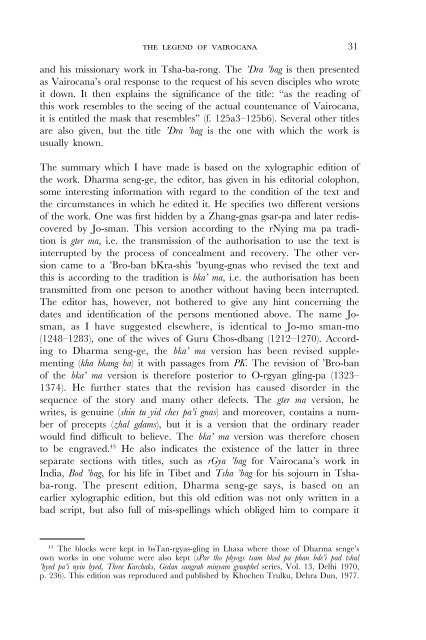You also want an ePaper? Increase the reach of your titles
YUMPU automatically turns print PDFs into web optimized ePapers that Google loves.
the legend of vairocana 31<br />
and his missionary work in Tsha-ba-rong. The ’Dra ’bag is then presented<br />
as Vairocana’s oral response to the request of his seven disciples who wrote<br />
it down. It then explains the significance of the title: “as the reading of<br />
this work resembles to the seeing of the actual countenance of Vairocana,<br />
it is entitled the mask that resembles” (f. 125a3–125b6). Several other titles<br />
are also given, but the title ’Dra ’bag is the one with which the work is<br />
usually known.<br />
The summary which I have made is based on the xylographic edition of<br />
the work. Dharma seng-ge, the editor, has given in his editorial colophon,<br />
some interesting information with regard to the condition of the text and<br />
the circumstances in which he edited it. He specifies two different versions<br />
of the work. One was first hidden by a Zhang-gnas gsar-pa and later rediscovered<br />
by Jo-sman. This version according to the rNying ma pa tradition<br />
is gter ma, i.e. the transmission of the authorisation to use the text is<br />
interrupted by the process of concealment and recovery. The other version<br />
came to a ’Bro-ban bKra-shis ’byung-gnas who revised the text and<br />
this is according to the tradition is bka’ ma, i.e. the authorisation has been<br />
transmitted from one person to another without having been interrupted.<br />
The editor has, however, not bothered to give any hint concerning the<br />
dates and identification of the persons mentioned above. The name Josman,<br />
as I have suggested elsewhere, is identical to Jo-mo sman-mo<br />
(1248–1283), one of the wives of Guru Chos-dbang (1212–1270). According<br />
to Dharma seng-ge, the bka’ ma version has been revised supplementing<br />
(kha bkang ba) it with passages from PK. The revision of ’Bro-ban<br />
of the bka’ ma version is therefore posterior to O-rgyan gling-pa (1323–<br />
1374). He further states that the revision has caused disorder in the<br />
sequence of the story and many other defects. The gter ma version, he<br />
writes, is genuine (shin tu yid ches pa’i gnas) and moreover, contains a number<br />
of precepts (zhal gdams), but it is a version that the ordinary reader<br />
would find difficult to believe. The bka’ ma version was therefore chosen<br />
to be engraved. 43 He also indicates the existence of the latter in three<br />
separate sections with titles, such as rGya ’bag for Vairocana’s work in<br />
India, Bod ’bag, for his life in Tibet and Tsha ’bag for his sojourn in Tshaba-rong.<br />
The present edition, Dharma seng-ge says, is based on an<br />
earlier xylographic edition, but this old edition was not only written in a<br />
bad script, but also full of mis-spellings which obliged him to compare it<br />
43 The blocks were kept in bsTan-rgyas-gling in Lhasa where those of Dharma senge’s<br />
own works in one volume were also kept (sPar tho phyogs tsam bkod pa phan bde’i pad tshal<br />
’byed pa’i nyin byed, Three Karchaks, Gedan sungrab minyam gyunphel series, Vol. 13, Delhi 1970,<br />
p. 236). This edition was reproduced and published by Khochen Trulku, Dehra Dun, 1977.

















